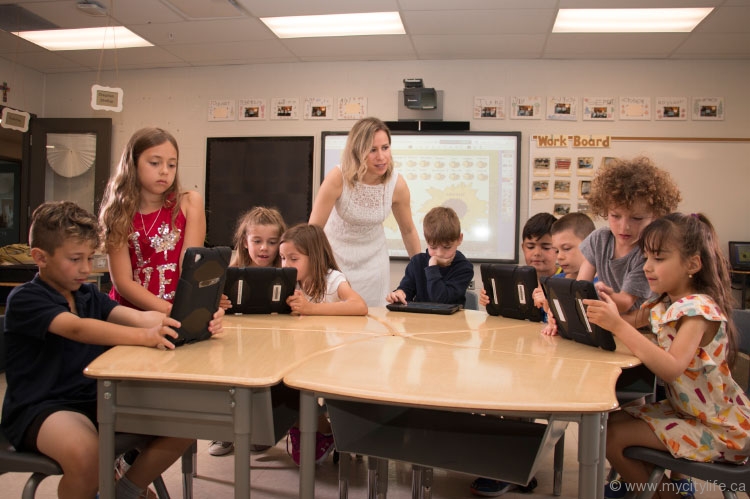The Digital Divide – Digital technology in education
Set foot in one of York Region’s new elementary schools and you may confuse the tech-drenched classrooms for the office space of a swanky startup on King Street. No chalkboards, no books, no paper — the York Catholic District School Board is ushering in a new era of education. City Life Magazine explores the impact of digital technology in and out of the classroom and its effect on IQ and development.
A quick search on Google for “kids and technology” will have you fielding a sea of articles that beg parents to ban screen time, with claims that tech use has proven links to ill-behaved children and those who lack creativity. Is this really the case? According to recent studies, kids are actually smarter than ever before. Take the Flynn effect, for example: in his study of IQ test scores for different populations over the past 60 years, researcher James Flynn discovered that IQ scores have risen from one generation to the next. IQ gains have increased steadily between 5 and 25 points, and since the advent of technology, the largest gains are occurring in tests measuring fluid intelligence as opposed to crystallized intelligence. Whereas crystallized intelligence relies more on long-term memory and reflects the ability to use experience and knowledge, fluid intelligence is defined as the capacity to reason and solve problems independent of any knowledge from the past.
According to Alyson Schafer, family therapist, author and acclaimed parenting expert, researchers have identified five factors that contribute to the increase of fluid intelligence: novelty, challenging yourself, creative thinking, doing things the hard way and networking. “Those are exactly the five components you would find in gaming, for example,” says Schafer.
The long and short of it is that technology is making learning fun, whether it be through gamification or digital integration, and studies show that increased engagement assists in the retention of information.
A Shift In Education
Guardian Angels Catholic Elementary School is just one of the new digital schools to pop up in York Region. From JK to Grade 8, students are utilizing the latest and greatest iPads, Chromebooks and interactive whiteboards to read, write and explore the curriculum in a new way.
Physical guided readers for young learners have been replaced with Raz-Kids, an online guided reading program with thousands of interactive ebooks, while agendas, photocopies and Duo-Tangs for each subject have been replaced with D2L, a virtual learning environment where students can view handouts, see their homework and turn in assignments.
Since its inception in 2015, school principal Diana Candido has worked tirelessly to help teachers and parents of Guardian Angels seamlessly and comfortably integrate this new approach into their classrooms and homes, respectively. “It has really become a part of our day; that’s when you know it’s authentic and not forced,” says Candido.
The elementary school principal is proud to be at the helm of such a forward-thinking institution, admitting the use of technology has helped to level the playing field for all types of learners. “The biggest improvement is looking at those children with different learning styles and needs and seeing how we’re opening up a whole new world for them,” she shares. “There are children whose brains work so beautifully, but they can’t put a word on paper, so you give them a device and now we know what they’re thinking.”
While the principal can’t comment to a noticeable improvement in grades just yet, she has noted a substantial increase in students’ energy and confidence, as well as an increased desire to go outside and interact with their peers at recess. “We try to maintain that balance, so we’re also nurturing the students’ love of play and the outdoors.”
Why The YCDSB Is On Board
“There is much research to support the idea that technology is engaging for students, and student engagement is a key component for learning,” says Diane Murgaski, superintendent of education for the YCDSB. The curriculum, special education and IT departments partnered with a broad-based committee of principals, central staff and educators to help plan and implement a strategy for aligning technology and the existing curriculum.
“It has enriched the opportunity for new pedagogical practices,” says Darlene Clapham, chief information officer for the YCDSB. She notes that when students can research and visualize concepts, it helps to stimulate communication, collaboration, innovation and problem solving.
The board admits that initially there were a number of parents concerned about the use of devices and online safety. The YCDSB maintains that student safety always takes priority, which is why schools have implemented digital discipleship teachings and have partnered with the regional police to promote the use of technology in ethical and responsible ways. “If students, guided by our Catholic values, use evolving technologies in responsible and respectful ways, they will become reflective, critical and creative digital disciples who contribute to the common good,” says Murgaski.
“The biggest improvement is looking at those children with different learning styles and needs and seeing how we’re opening up a whole new world for them.” — Diana Candido, Principal, Guardian Angels Catholic Elementary School
An Alternative Approach
Katie Ketchum, director of admissions and marketing at Toronto Waldorf School, shares the institution’s belief in using “the right thing at the right time.” The private school has a reputation in the GTA for being low-tech, and it is true. Toronto Waldorf School’s method is built upon a foundation that also includes academic integration, focus on “how to think” rather than “what to think,” environmental stewardship and experiential learning.
Upon admission, educators encourage parents to enforce a “no screens” policy at home from Monday to Friday. Of course, this is not set in stone or in any official contract, but Ketchum says it is important, especially for the younger students. “Firstly it’s just about maintaining face-to-face human experience,” says Ketchum. “For us, at that stage, a lot of the focus is on building social and emotional intelligence and self-regulation.” She adds that when technology is introduced prematurely, it teaches instant gratification, and children’s brains are becoming accustomed to this. “What we want for children, as long as possible, is to protect their inner space and imagination,” says Ketchum.
Waldorf doesn’t discount technology altogether, but takes it back to basics, showing students exactly where the first technologies began and how they’ve evolved to be the computers we wear on our wrists today. Throughout the hands-on curriculum, students first discover the loom and its connections to weaving and computing. Emphasis is placed on understanding how these old technologies have developed in the long history of human knowledge.
“We’re knitting and students are learning to make their own patterns when they knit (which is binary), so we use that as our jumping board later for coding,” says Ketchum. “We also want to be doing things like weaving and knitting because the experience is meaningful, and when a human being connects to an experience, they tend to remember it.”
The Toronto Waldorf School is no outlier. Even the late Steve Jobs, founder of Apple, was known to limit tech time at home — his kids weren’t initially allowed on the iPad.
What The Experts Have To Say…
“Stop using the word ‘addicted,’” says Schafer. “Parents tend to say technology is addictive because [kids] like it. Well, kids like candy, but it doesn’t mean they’re addicted.” Schafer admits that too much of anything (even water) is not ideal, but while “real addiction” does exist, misusing the word “addicted” is dangerous. Instead, Schafer encourages technophobic parents to swap “addicted” for “passionate” or “engaged” instead.
The family therapist admits that it’s not a child’s fault for not wanting to go off-line when devices are designed to keep them on there. She says it all comes down to setting reasonable limits and being aware of what your kids are doing online. She even suggests parents visit Common Sense Media to get a better understanding of the apps, games and YouTube channels their kids are visiting. The site provides independent ratings, reviews and other helpful tools for parents.
In many instances, technology has also proven to have a positive effect on brain development and stimulation outside the bounds of education. Schafer shares that stimulating the visual cortex after you’ve seen a traumatic image, like a car accident, reduces post-traumatic stress and flashbacks.
There are also app developers like Mighteor who have created Bioresponsive Games™ to help children with behavioural and emotional challenges learn how to manage their emotions throughout the day. According to the website, kids wear a Mighty Band heart-rate monitor that controls game difficulty, and to succeed in the games, they learn skills to stay focused and in control.
The potential of technology is ever-evolving, and our digital natives are leading the way. In their book, Born Digital, authors Palfrey and Gasser divulge that the digital revolution has already made the world a better place and maintain that digital natives have every chance of propelling society further forward in myriad ways — if we let them. “So many times there’s this need for control, but the children will guide us,” says Candido. “And if we allow them to, it’s going to be incredible, where they’re going to go.”
gna.ycdsb.ca
www.ycdsb.ca
www.torontowaldorfschool.com
www.alysonschafer.com
Photo By carlos a. pinto




















































































1 Comment
Great piece, I personally went to Toronto Waldorf School from Parent & Tot to eight grade and felt totally unprepared going into high school. I think implementing a healthy dose of technology into schools is really important in order to help kids succeed in the workplace.